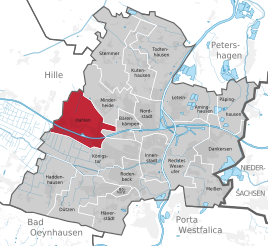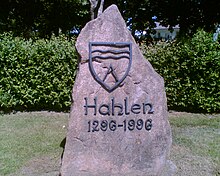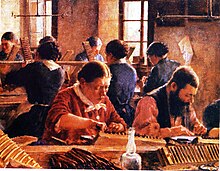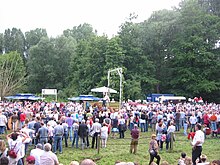Hahlen
|
Hahlen
City of Minden
Coordinates: 52 ° 18 ′ 20 ″ N , 8 ° 50 ′ 41 ″ E
|
|
|---|---|
| Height : | 54 m above sea level NN |
| Area : | 7.95 km² |
| Residents : | 3821 (Dec. 31, 2013) |
| Population density : | 481 inhabitants / km² |
| Incorporation : | 1st January 1973 |
| Postal code : | 32427 |
| Area code : | 0571 |
|
Location of Hahlen in Minden
|
|
Hahlen is a district of Minden . It is located on the western edge of the Weser city. At the end of 2008 the district had around 3800 inhabitants.
Hahlen has a village origin with numerous agricultural properties still today. This occupies the western part of the district. In the eastern part, numerous new settlements were built in the 1950s.
The district is shaped in the south by the course of the Mittelland Canal . In the northern part of the district there is a railway line operated by Mindener Kreisbahnen GmbH (MKB), which is also used by the Mindener Museumseisenbahn .
geography
Geographical location
The district of Hahlen is located in the west of the urban area of Minden, about five kilometers from the city center. The former village of Hahlen is just like Hartum , Südhemmern and Hille on the southern edge of the Hartumer Loessplatte with its good and easy to work soil and north of the Wiehengebirge and the Bastau lowlands . The central position between pasture and arable land in a place with favorable water supply was decisive for the choice of the settlement area. The terrain drops from north to south from up to 60 meters above sea level on the heath to up to 45 meters above sea level in the Bastau lowlands. The Mittelland Canal crosses the district from east to west roughly along the border between the Bastau valley and dry soils.
In the north and east, Hahlen borders the districts of Minderheide and Bärenkämpen , in the south on the district of Königstor in the city of Minden and in the west on the districts of Hartum and Holzhausen II in the municipality of Hille . The population of Hahlen distinguishes between further districts in their village, from west to east these are: the Drögen, the Hahnenfeld, the Wiebusch, Osterhahlen and the Dalhof.
Geology and soils
The loess of the Hartum loess plate, which was deposited during the last ice age , is today largely decalcified, converted to loess clay and subject to erosion in many places . It has an average thickness of 2 meters in the strip of land that stretches along Hahler Strasse and north of Hahlen to Hartum. Under this top layer of soil there is a relatively narrow mostly gravelly-stony layer. These are the remains of the ground moraine from the penultimate (Saale) glaciation . The layer below, the so-called middle Weser terrace, which consists of red-brown sand and gravel and forms a rich groundwater carrier, is of greater importance.
The Bastauwiesen (formerly known as Ritterbruch) south of the village are an extension of the large peat bog near Hille. The moor emerged as a high moor from a rivulet lake of the Weser, which flowed here along the Wiehengebirge during the Saale Ice Age, as its path to the north was blocked by glaciers. After the glaciers had receded, the old arm of the river was cut off and a lake landscape formed. This lake slowly began to silt up and the high moor was formed.
history
First settlement
Finds from 1938 from the Roman Empire testify that the history of settlement goes back a long way. The permanent settlement of this area and with it the emergence of the villages is assumed for the period from the 1st to the 4th century AD. Hahlen was first mentioned in a document on June 13, 1296 in a purchase contract from the then Minden Bishop Ludolf , who sold a house and the tithe of two hooves in "halls".
The old field names and forms suggest that before the medieval expansion of the villages on the southern edge of the Hartumer Loessplatte, only a strip of land about 1 km wide had been cultivated. All terrain outside of this old settlement area on the edge of the plate (i.e. north of Hahlen) was still covered with forest and heather until the beginning of the 12th century. Remnants of the forest were still present as "Hahler Busch" and "Hartumer Busch" until the 18th century.
Middle Ages and Reformation
Hahlen was less affected by the medieval feudal system than villages in many other regions. Although the farmers had made contributions to the Minden bishops and after the Peace of Westphalia in 1648, the Brandenburg-Prussian Elector afford, but there were no mortgaged landlords such as a landowner of the serf peasants "possessed". Between around 1500 and 1540 there was a dispute between the villages of Hahlen, Hartum and Südhemmern and the city of Minden over the Ritterbruch (today Bastauwiesen) and the rights of use for peat cutting and pasture land. In this context, the first pictorial representation of the area was created, which has been preserved to this day.
The Marienkapelle has been in the center of the village since 1503 . In 1530 the Minden parishes, to which Hahlen belonged, broke away from Catholic doctrine and became Protestant. The bell of the Lady Chapel was taken down in 1679 when French troops invaded (during the Great Elector's wars with Louis XIV) and was probably used for the manufacture of cannonballs. This is passed down by the inscription on the current bell from 1680. The inhabitants of Hahlen fled from the French troops to Lavelsloh, about 15 km away .
It is documented for the first time in 1649 that a teacher was called to Hahlen, to a school in the immediate vicinity of the chapel, in which 24 children were taught at the time.
Modern times, battle of Minden and under the Prussians
The second half of the 17th and the first half of the 18th centuries were relatively calm overall. The village was not affected by any major wars and economically the country recovered from the aftermath of the Thirty Years War . However, there were two major fires that killed several houses.
In the battle of Minden on August 1, 1759, Hahlen was the battlefield, and the village was first occupied by the French in the early morning, after they had to retreat during the battle, English cavalry under Lord George Sackville advanced from Hartum. 35 houses in the village were destroyed by the fighting.
During the occupation by Napoleon, many young men were forced to serve in the French army and also to take part in the campaign to Russia, many of them never returned.
After the end of Napoleonic rule (1806-1813) and the reorganization of Prussia, Hahlen belonged to the Hartum administrative district in the Minden district / Minden district / Westphalia province . In 1820/21 a new schoolhouse was built that was used until 1927. Today it is the oldest surviving school building in the Minden-Lübbecke district. With the introduction of the rural community order in 1844, Hahlen was given the status of a self-governing body . A local council headed by fourteen mayors from 1844 to 1972 directed the affairs of the community. The administrative work itself was in the hands of the bailiff of the Hartum Office .
19th century, industrialization and structural changes
From the time of the revolution of 1848 , the story has been handed down that on March 27th about ten Hahlers moved in front of the house of the bailiff Lüttgert in Hartum to demand changes. Since their demands remained unclear, however, they withdrew after attempts by the authorities to appease them.
As early as the 16th century, the prevailing inheritance law , which did not permit the division of farms, resulted in the rapidly growing, non-established landless stratum of the heuerlings in the entire region . After initially there were only a few heuerlings in Hahlen, their number increased sharply from the middle of the 19th century. In the villages of the Minden-Ravensberger Land there was an increasing wave of emigration to North America. Many people from the Mindener Land - and thus also from Hahlen - moved to Holland to mow grass in the summer. In 1852 a branch of the Minden cigar factory vd Heyde started operations in Hahlen. The tobacco and cigar industry was economically promoted by Prussia in order to curb emigration and migrant work ( Holland travelers ). With the increase in residents who were employed in industry, the structure of the settlement began to change, and at the end of the 19th century the first workers' houses were built along Hahler Strasse. This started the development that made Hahlen a suburb of Minden, in which the settlement areas of town and village can no longer be separated from one another.
In 1906, 13 workers - most of them cigar workers - founded a local SPD association. Between 1906 and 1915 the Mittelland Canal was built to which some buildings in Hahlen had to give way. On March 26, 1913, the Hahlen Volunteer Fire Brigade was founded, which today belongs to the Minden Volunteer Fire Brigade as the Hahlen fire fighting group .
By the beginning of the Second World War , the cigar industry declined and more and more people commuted, for example on the MKB route, from Hahlen to Minden, where new industries such as Melitta , with more interesting jobs, had now settled.
From the post-war period until today
After the Second World War, the population rose sharply, which was mainly due to the influx of refugees and displaced persons. In 1946, according to the local council protocol, 1250 refugees were to be accommodated in the community. In 1950, 453 displaced persons were still living in Hahlen. In the following time, the roads and the sewer system were further developed and the housing estates on Petershäger Weg and on the Mittelland Canal were built.
As a result of the regional reform , the previously independent municipality of Hahlen was incorporated into the city of Minden on January 1, 1973 as a district . An uninhabited part of the community (1.61 km²) was reclassified to Hille . Until December 31, 1972 Hahlen belonged to the Hartum office .
Coat of arms and place name
The coat of arms shows on a red background in the upper part a horizontal silver wavy bar and in the lower part a silver tip pointing upwards. The combination of red and silver wants to remind of the centuries-old affiliation of the area to the prince-bishopric of Minden. The silver waves are supposed to represent the Mittelland Canal, the course of which is characteristic for the village. The silver tip is supposed to remind of the origin of the place name Hahlen, which was traced back to Old Norse, Danish and Anglo-Saxon words such as hali, hale or healch, which mean something like "corner" or "pointed property".
Today, however, there are different interpretations of the origin of the place name. In addition to the interpretation “corner” and “pointed property” represented by Jellinghaus , the view was later taken that the name Hahlen derives from the Low German word “hal”, which can mean “dry”. Since the oldest farms in Hahlen on Dorfstrasse are already on the edge of the Bastau moor and are partly on moorland, another explanation should be sought in the Low German pronunciation of “Haohlen”, which can mean, for example, hollow, hole, low and swampy place . Thus the place name Hahlen could also be the name for a settlement in a low-lying, swampy place.
Population development
|
language
Hahlen is in the Low German-speaking area, the local dialect belongs to the East Westphalian dialect group of Low German . Since the end of the Second World War, however, the High German language has largely prevailed and replaced the Low German. Low German still plays a role as a colloquial language, especially among the older villagers. This language is also cultivated by the Low German Laienbühne Hahlen and presented at theater evenings.
religion
The majority of the population is Evangelical Lutheran , around 60 percent of the population belong to the parish. Today Hahlen belongs to the parish of Hartum, which consists of the two districts of Hahlen and Hartum. In the pre-Reformation period, Hahlen was ecclesiastically assigned to the city of Minden, then Hahlen belonged to the newly formed parish of Hartum. The large church in Hartum was the main church of the four villages Hartum, Hahlen, Holzhausen and Nordhemmern until 1904.
politics
Results of the local elections
As a district of Minden, the population of Hahlen is represented in the Minden city council ( city council ). The constituency of Hahlen consists of the two constituencies Michael-Ende-Schule and Sparkasse Minden-Lübbecke. In the local elections in 1999, 2004, 2009 and 2014, the parties in the Hahlen constituency won the following voting shares:
| election day | SPD | CDU | FDP | GREEN | Minden Initiative | The left | Citizens Alliance Minden | The Republicans | AfD | Pirates | |
|---|---|---|---|---|---|---|---|---|---|---|---|
| September 12, 1999 | 41.7% | 42.9% | 5.3% | 6.6% | 3.5% | 0.0% | 0.0% | 0.0% | 0.0% | 0.0% | |
| September 26, 2004 | 40.23% | 37.62% | 5.79% | 7.57% | 8.79% | 0.00% | 0.00% | 0.00% | 0.00% | 0.0% | |
| August 30, 2009 | 41.96% | 34.02% | 6.02% | 7.22% | 4.88% | 3.19% | 1.81% | 0.90% | 0.00% | 0.0% | |
| May 25, 2014 | 45.60% | 30.14% | 3.58% | 6.61% | 3.09% | 3.76% | 1.46% | 0.00% | 3.88% | 1.46% |
Mayor and Mayor
From 1843, Hahlen was an independent municipality with an elected mayor and council, in the Hartum office. Since the territorial reform in 1973, the population of Hahlen has been represented to the council and administration of the city of Minden by a mayor who is elected by the city council of Minden on the basis of the election results.
Mayor:
- 1843–1849: Beermann, Friedrich Wilhelm Heinrich, Hahlen 1
- 1849–1861: Rösener, Wilhelm Ehrenreich, Hahlen 3
- 1862–1874: Südmeier, Johann Heinrich Christian, Hahlen 59
- 1874–1892: Spönemann, Johann Heinrich Christian Wilhelm, Hahlen 37
- 1892–1904: Horstmann, Heinrich, Hahlen 22
- 1904–1912: Riechmann, Wilhelm, Hahlen 3
- 1912–1923: Beckmeyer, Heinrich, Hahlen 20
- 1923–1929: Rohlfing, Wilhelm, Hahlen 26
- 1929–1933: Meier, Hermann, Hahlen 235
- 1933–1935: Meyer, Hermann, Hahlen 86
- 1935–1945: Spilker, August, Hahlen 75
- 1945–1946: Kruse, Christian, Hahlen 174
- 1946–1964: Meyer, Heinrich, Hahlen 235
- 1964–1972: Schnittker, Walter
Mayor:
- 1973–1975: Schnittker, Walter
- 1975-2000: Pohlmann, Wilhelm
- 2000–2004: Berthold, Hans-Uwe CDU
- 2004–2013: Brandt, Heinz-Günther SPD
- since 2013: Wesemann, Werner SPD
Culture
Sports
The sports club TSV Hahlen , founded in 1945, is one of the largest sports clubs in Minden. Handball forms the focus with the first men's and women's teams (Association or Oberliga Westfalen), but a number of other sports are offered: In addition to table tennis and badminton, TSV Hahlen is also active in popular sports .
Regular events
- Wreath riding
The traditional wreath riding in Hahlen takes place every year on the penultimate weekend in July in the moor arena in Hahlen. This competition has been held among village youth since 1921. The aim is to grab a wreath hanging from a scaffolding, the gallows, by hand from a galloping horse and tear it off. After several rounds, the winner is determined. He is then the Kranzreiter president and elects a president. The presidential couple can now rule the riders for a year.
- May celebration (dance in May)
Since 1946, a May Day celebration has been held in Hahlen on May 1st . The origins of this custom with the setting up of maypoles and dancing go back much further in Hahlen. Later came the “Labor Day” which was celebrated by trade unionists and social democrats. Today every year on the evening of April 30th, the children of the primary school open the May Day celebration with dances around the maypole. A tent party with rides takes place behind the sports field .
Club life
The population of Hahl organized a lively club life in their place. The most important clubs, associations and institutions include:
- Gymnastics and Sports Club Hahlen since 1945 eV (TSV)
- Kranzreiterverein Hahlen
- Minden volunteer fire brigade - Hahlen fire fighting group
- Mixed choir Minden-Hahlen eV
- Mindener Yachtclub eV
- Shooting club "Auf's Blatt" Hahlen
- Tournament community Mindener Land
- Drummer and Pfeiferkorps 1980 Minden eV
- Pedigree Poultry Breeding Association Hahlen
- Local agricultural association
- SPD local association Hahlen
- CDU local union Hahlen
- CVJM Teestubenarbeit eV
- Low German amateur stage in Hahlen
particularities
- Hail holiday
On June 14th 1680 the harvest was destroyed by a devastating hailstorm. Since then, a harvest supplication service has been held in the villages of Hahlen, Hartum, Holzhausen, Nordhemmern and Südhemmern on the Monday after Trinity . To this day one speaks of the " hail holiday ", especially since it was a public holiday in the mentioned communities until the 1950s.
literature
- Christian Frederking: Low German village dictionary of the village of Hahlen near Minden in Westphalia: vocabulary, proverbs, folklore. Minden History Association, 2005, ISBN 3-929894-30-0 .
- Christian Frederking: Chronicle of the village of Hahlen near Minden i. W. and its surroundings: A village life around 1870. Bruns 1931.
- Heinz Voter: Hahlen: a lively place with an ancient history. City of Minden, 1990, DNB 921453949 .
Web links
- City of Minden
- Page about the Minden-Hahlen district
- Hahler wreath riding
- Hahlen in the Westphalia Culture Atlas
Individual evidence
- ↑ Population statistics of the city of Minden ( Memento from April 28, 2015 in the Internet Archive ), accessed on October 13, 2014.
- ↑ a b Werner Nellner: The natural foundations of the settlement of the Mindener country , Bruns 1953, pp. 20-23.
- ↑ Moortalk homepage accessed in February 2016.
- ↑ Werner Nellner: The natural foundations of the settlement of the Mindener country. Bruns 1953, p. 25.
- ↑ Brandhorst: 700 Years of Hahlen - Contributions to the history of the village and new things from the anniversary year. Issue 1, Gem. Hahler Vereine 1996, p. 11 f.
- ^ PF Weddigen: New Westphalian magazine on geography, history and statistics, third volume, issue 9-12. (Digitized version) 1792, p. 128 f. , accessed April 3, 2011 .
- ↑ Heinz Voter: Hahlen: a lively place with an ancient history. City of Minden 1990, p. 4.
- ^ Frederking: Chronicle of the village of Hahlen. P. 104.
- ↑ Landgemeindeordnung for the Province of Westphalia (PDF file; 1.6 MB), accessed in April 2011 in 1841.
- ^ Frederking: Chronicle of the village of Hahlen. P. 134.
- ^ Rolf Momburg: The cigar makers. Verlag Kurt Meyer, Hüllhorst 1996, p. 30.
- ↑ Final report: Our village has a future (PDF file; 6.8 MB), Minden-Lübbecke district 2008, p. 76, accessed in April 2011.
- ^ Federal Statistical Office (ed.): Historical municipality directory for the Federal Republic of Germany. Name, border and key number changes in municipalities, counties and administrative districts from May 27, 1970 to December 31, 1982 . W. Kohlhammer, Stuttgart / Mainz 1983, ISBN 3-17-003263-1 , p. 326 .
- ↑ Martin Bünermann, Heinz Köstering: The communities and districts after the municipal territorial reform in North Rhine-Westphalia . Deutscher Gemeindeverlag, Cologne 1975, ISBN 3-555-30092-X , p. 116 .
- ↑ HF Jellinghaus: The Westphalian place names according to their basic words. Schöningh, 1923, p. 75.
- ↑ Brandhorst: 700 Years of Hahlen - Contributions to the history of the village and new things from the anniversary year. Issue 1, Gem. Hahler Vereine 1996.
- ↑ Homepage of the parish Hartum, About us, parish concept accessed in August 2010.
- ↑ Municipal computer center Minden-Ravensberg / Lippe Municipal election 1999 ( Memento from August 4, 2012 in the web archive archive.today ) (1999) accessed in September 2010.
- ↑ Municipal data center Minden-Ravensberg / Lippe (2004 and 2009) accessed in September 2010.
- ↑ Municipal data center Minden-Ravensberg / Lippe (2014) accessed in June 2014
- ↑ Heinz Voter: Hahlen: a lively place with an ancient history. City of Minden 1990, p. 5.










